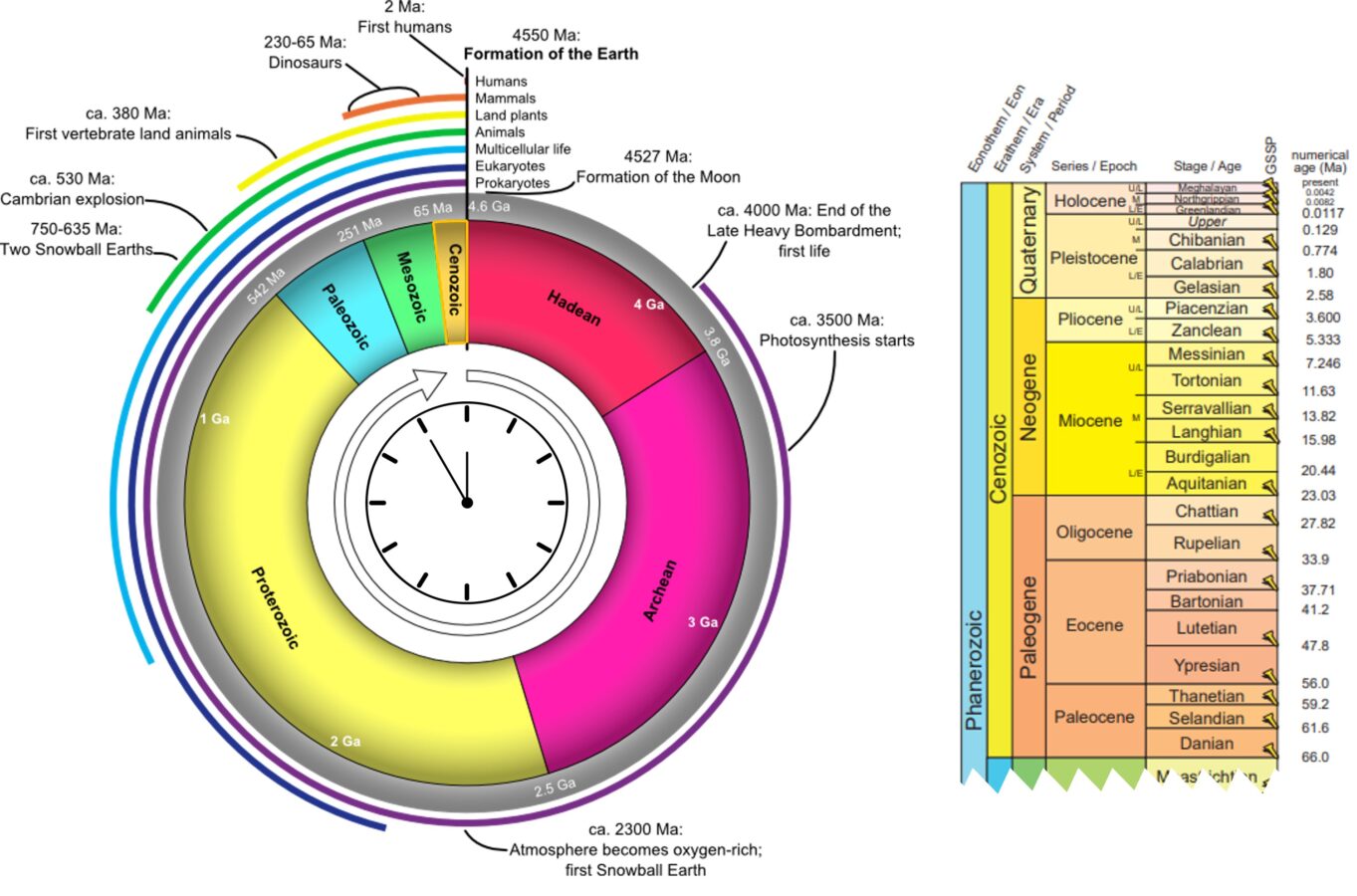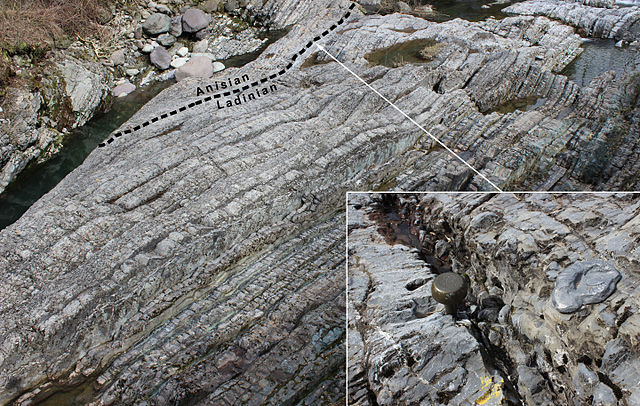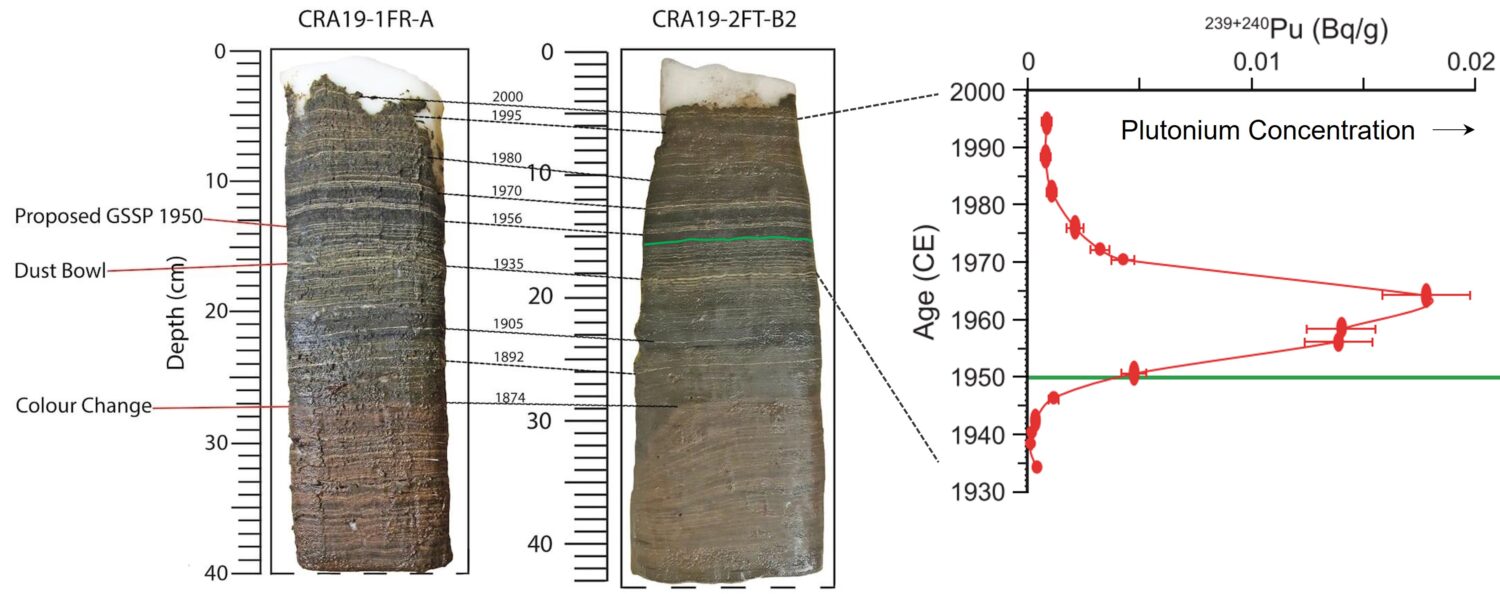Humanity’s relationship to time is notoriously myopic. We tend to perceive things as permanent and immutable only because their rate of change is imperceptible on the timescales of our own experience. When it comes to geologic time, the disconnect between our lived experience and the magnitude of Earth history is almost irreconcilable. How we mark time, therefore, depends a lot on perspective.
I’ve spent much of my research career steeped in Earth science and planetary evolution, including teaching undergraduate geology. Geologists are trained to appreciate the inconceivably large span of geologic time (or ‘Deep Time’) as well as the relative brevity of human presence on the planet. Earth scientists subdivide the planet’s 4.6 billion year history into eons, eras, and epochs as most of us mark our lives in months, weeks and days. Even those of us forced to confront these immense scales in our work often struggle to reconcile the fact that recorded human history (roughly the last 5000 years) only represents 0.0001% of Earth’s history. Put another way, if Earth’s history was represented by a 24-hour day, everything from the early Bronze age onwards happens in the last ~1/10th of a second.
Recently, debate has raged in the geologic community about the possibility that we are now in a new geologic epoch defined by human impact on the planet, hence referred to as the ‘Anthropocene’ (from the Greek Anthropos, for human). Depending on which side of the debate you’re on, this proposal is either a manifestation of human conceit given our short tenure on this planet or a grim recognition that in that short time, we have managed to embed our presence in the geologic record such that it will be permanently recognizable even if humanity were to disappear tomorrow.
Defining a new geologic epoch is no small feat. The present epoch, called the Holocene, started 11,700 years ago though many epochs span tens of millions of years (roughly three orders of magnitude or 1000 times longer). Divisions on the geologic timescale are not arbitrary. They are defined by measurable events and of the 115 intervals on the International Chronostratigraphic Chart, 80 of them are associated with a physical site where geologists can literally touch the stratigraphic boundaries which are marked with so-called ‘golden spikes’. Just as Greenwich defines the line of zero longitude, these golden spikes define a reference in time and space that can be geochemically dated and associated with a major transition in Earth history.

Ominously, many of these boundaries are defined by extinctions – e.g. fossils of a given species appear in strata below the boundary and not above in the stratigraphic column. This is true for the Ordovician, Devonian, Permian, Triassic, and Cretaceous. The latter of these is well-known as the point, 65 million years ago, when a large impact struck the Yucatan peninsula ending the reign of the dinosaurs and spreading a measurable trace of iridium metal from the impactor into the sedimentary record around the globe.

Formally recognizing the present as the Anthropocene therefore requires defining a golden spike that characterizes human presence on Earth – what, then, is the unmistakable fingerprint of civilization? Where and how do we identify it?
We are what we leave behind
Archeological traces of our human ancestors such as firepits or middens have been suggested as one of the first markers of human culture (going back hundreds-of-thousands of years) but archaeological evidence is both spatially and temporally dispersed and can be hard to discriminate from natural phenomena in the absence of other artifacts. The ideal golden spike is one that can be correlated globally everywhere a given strata is exposed at the surface.
An obvious choice may be to consider the geochemical effect of the enormous increase in CO2 emissions that mark the post-industrial revolution and which drives anthropogenic climate change. Other proposals suggest that future geologists would recognize changes in erosion and sedimentation rates that result from human land use. Land-use changes also imprint as geochemical perturbations in the cycles of nitrogen, phosphorous and carbon from industrialized agriculture and urbanization.
We may also imagine that the appearance of synthetic materials (e.g. plastics, concrete and refined metals) will mark the sedimentary record, unmistakably immortalizing human materialism and waste. While all of these are compelling, they each present challenges and ambiguities.
Recent site proposals for the Anthropocene’s golden spike have increasingly focused on the diminutive Crawford Lake in Ontario, Canada. Core samples from the bottom of the lake reveal fine-grained sediments, neatly laminated in annual layers, analogous to the annual rings of a tree. Careful dissection of those layers yields particles of soot, logging debris, and pollen, all of which indicate the history of human habitation in the area, including changing agricultural and forestry practices. Amongst the time recorded in these sediments however, perhaps none stands out more starkly than the mid-twentieth century when an unmistakably human signature arrived from thousands of miles away.
Our signature is written in plutonium
From the moment the Trinity device was detonated in the New Mexico desert in 1945, plutonium and uranium isotopes have been deposited around the globe as fallout from 528 above-ground and atmospheric nuclear tests. A recent study shows that fallout from Trinity alone reached 46 states. Much like the widespread iridium anomaly associated with the Cretaceous-Paleogene boundary, radioisotopes from nuclear weapons development spread widely and define a narrow window in time from 1945-1963, when the Partial Test Ban Treaty ended above-ground testing. Because plutonium is a man-made element, it is incontestably distinguishable from natural phenomena and its long half-life (24,100 years for 239Pu) means it will be measurable far into the future.
The uptick in plutonium turns out to be one of the clearest, most temporally-distinct features amongst the many signatures of human existence. Wherever sediments from the post-war era are undisturbed, it will become part of the rock record globally.

The plutonium spike is not the only nuclear artifact with implications spanning deep time. Disposal of highly-radioactive nuclear waste in geological repositories also leads to debates over how to identify the hazard for posterity, including the dystopian scenario in which today’s written records have ceased to exist or are unintelligible. Much like the golden records launched on the Voyager Missions, the problem of nuclear waste is so long-lived that experts debate whether we must resort to pictographs to deter future generations from unearthing the toxic residue of the atomic age. The question of how to label Pandora’s box remains unanswered.
Where our geologic history and our nuclear present meet
The definition of the Anthropocene is technically agnostic with regard to the origin or intended purpose of the radioisotopes that may come to define the human epoch. Such an agnostic view unfortunately overlooks the unsettling fact that control of nuclear reactions is simultaneously one of our greatest technical achievements and also the one with the greatest potential to destroy our own species.
The Bulletin of the Atomic Scientists recognizes this threat with their famous ‘Doomsday Clock’, which inches closer to midnight to symbolize humanity’s peril. It is currently set at 90 seconds to midnight but in geological terms, that is exceedingly optimistic.
On our 24-hour clock of Earth history (in which the Bronze age began 1/10th of a second ago) nuclear weapons were invented in the final 1/1000th of a second. It is truly unique in Earth history for a species to flourish in such a short time while simultaneously applying the peak of its capabilities to threaten its own self-destruction. It warrants reflection to consider that this may be our most defining trait, worthy of the golden spike for our time on the planet.
Unlike the existential threat of climate change, we can immediately eliminate the threat of nuclear weapons by choice, given the will. We can and should acknowledge that our dependency on nuclear weapons is based on a false sense of security, lest the true golden spike for the Anthropocene be our own extinction.


